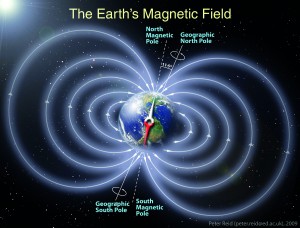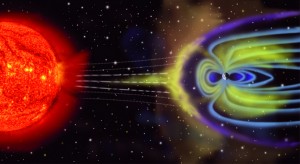The Magnetic Lines, the Magnetic Field and Polar Shift
The electromagnetic grid, unlike the geomantic grids, is vital; it maintains the magnetic field of all living beings. It protects us from harmful radiation from space and from too much magnetic flux during solar storms; its magnetosphere shields us from the charged particles borne by the solar wind. The magnetic field lines themselves, which generate the magnetic field are straight, but the particle path runs in a spiral around these lines. The field lines emerge in a circular pattern from the South Pole and re-enter the earth at the North Pole. Near the earth’s surface, the field they generate resembles a magnetic dipole, a bipolar circular field in the shape of a helix, a horizontal figure eight, formed by two spheres. Within the earth’s mantle, the shape of the magnetic field changes to a quadrupole field and in the interior to a multipole field.
Propulsion from the geodynamo
The emergence of the earth’s magnetic field as a geodynamo remains controversial to this day. The only thing scientists do agree upon is that within the outer magnetic field, an energy potential of 1,018 joules is stored (1 J x 2.778 kWh = 2,828 kWh) and the energy in the inner field must be two orders of magnitude higher (around 5,656 kWh). A planet must fulfill the following prerequisites within its core to generate a magnetic field and geodynamo:
• There must be a strong source of energy available so that the liquid material in the planet’s core can be circulated by convection. The earth’s core is incredibly hot; scientific estimates put its temperature at as much as 5,000° C, which is the temperature of the sun’s surface. The original energy source was the thermal energy from the earth’s solar past. Then came the heat generated by the radioactive decay of uranium and thorium and the crystallization heat released by the progressive cooling of the outer core. The hot, liquid, but less dense iron in the earth’s core rises to the mantle, where it emits some of its heat and then subsides again.
• The planet must rotate so that the convection flows in the earth’s interior are forced into a spiral by their own inertia (Coriolis Effect). These convection currents in the earth’s outer core (liquid iron whose volume is six times that of the moon) that are maintained by the huge temperature differences between the earth’s mantle and its core generate the actual magnetic field. The electrical principle of a dynamo involves the generation of electrical current and thus a magnetic field, by means of movement in an electrically conductive molten mass, which is why this phenomenon is referred to as a geodynamo. The flow in the earth’s core, which has a diameter of 3,000 km, is only a few meters each year but that is enough to maintain the magnetic dipole moment.
• There must also be a large amount of an electrically conductive liquid, which there is in the earth’s outer core. It contains a great deal of iron and surrounds the inner, solid core, which is almost pure iron. These materials themselves are not magnetic, but their polar movement causes them to store energy much like a bipolar battery, which maintains the magnetic field. It must also be ionized and this is accomplished by the extremely high temperatures in the earth’s core; thus the geodynamo runs like a perpetual motion machine that supplies itself with energy.
Reduction of the magnetic field
The magnetic field flux has decreased drastically in the past 200 years. Since measurements began in 1830, its strength has declined by almost 10% – nearly 6% in the last 100 years. The measurement data provided by “Champ”, the German research satellite, also confirmed that the magnetic field has declined by almost 2% since 1979. The largest decline was measured over the South Atlantic, where the magnetic field has weakened by about 10% in only the last 20 years. This phenomenally fast reduction in the magnetic field has so far received no scientific explanation; even if the geodynamo were to stop suddenly and completely, the earth’s magnetic field would drop off much more slowly – theoretical calculations indicate a time frame of 10,000 years.
A weaker magnetic field has serious consequences for the earth and every living thing, but we cannot immediately recognize or perceive them. However, our high-tech devices react to them directly; the transmission of digital data, television and radio programs and telephone conversations via long-distance communications satellites are much more susceptible to disruption. Particle streams from solar storms repeatedly paralyze radio traffic and put satellite and radar systems out of operation.
The reduction in the magnetic field is also the reason why schools of whales are increasingly beaching themselves and flocks of migratory birds deviate greatly from the routes they have used for millennia; these animals orient themselves on the magnetic lines that are now shifting and becoming weaker.
Polar drift and polar shift
An accelerating movement of the poles away from their current positions has been observed in recent years. There is speculation that the earth’s magnetic field is reversing polarity and forming an opposite field, a process which will bring about the collapse of the magnetic field much more quickly than previously assumed. Calculations based on simulations show that chaotic disturbances that can lead to a magnetic field pole reversal and thus a pole shift occur cyclically (see page 656).
This is just a small excerpt from the book GAIA LEGACY.


